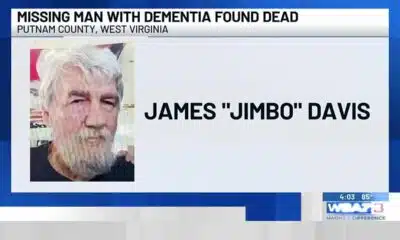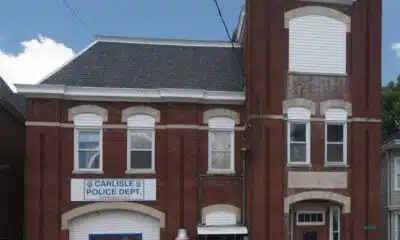News from the South - North Carolina News Feed
Patient called for help from Mission bathroom 29 minutes before someone found him. By then, his heart stopped, new report shows.
A patient who died in February after calling for help in a Mission Hospital emergency department bathroom went 29 minutes with no response as multiple staff members passed by the door with a call light flashing above, according to documents obtained by Asheville Watchdog.
By the time an employee entered the bathroom, the 54-year-old patient was slumped in a wheelchair, unresponsive, his heart no longer beating.
HCA Healthcare-owned Mission was found in violation of federal emergency care regulations that could have resulted in a loss of federal funding, a potentially devastating blow to the region’s largest health care provider. But because Mission discovered the violation and took “corrective action” prior to the arrival of health care regulators, the U.S. Centers for Medicare and Medicaid Services (CMS) chose not to terminate the hospital’s Medicare agreement, according to a July 15 letter to the hospital’s chief executive, Greg Lowe.
The failure of Mission staff to quickly respond to the dying patient in the emergency room bathroom came just over a year after Mission was cited by CMS, in December 2023, for violating federal standards of care leading to the deaths of four patients and the harm of 14. CMS found then that conditions at the hospital put patients in immediate jeopardy of severe harm or death.
Immediate jeopardy is the most serious sanction a hospital can face. CMS lifted the immediate jeopardy finding 23 days later after Mission submitted a plan for corrections.
The circumstances surrounding the patient in the bathroom, first reported by The Watchdog in February, were among the issues examined in an unannounced inspection by surveyors with the North Carolina Department of Health and Human Services in mid-May.
In a 12-page report that previously had not been made public, the investigators described the circumstances of the man’s death, from his arrival at the emergency department to the frantic but unsuccessful efforts by hospital staff to revive him.
Mission Hospital spokespeople did not immediately respond to a request for comment. Spokespeople with National Nurses United, the labor union that represents nurses at Mission, did not respond to a request for comment. The union and local nurses have complained about alleged understaffing at Mission since for-profit HCA bought the formerly nonprofit health system in 2019.
Identified in the report as “Patient #41,” the man arrived by ambulance at 10:50 p.m. on Feb. 10, complaining primarily of shortness of breath. He had a history of leukemia and non-Hodgkin’s lymphoma, blood cancers, and chronic obstructive pulmonary disease or COPD.
“The only thing that helps my COPD is 2 oxycodone plus a shot of dilaudid,” the man told Emergency Medical Services workers on the way to Mission, according to the report.
Hospital staff triaged the patient six minutes after he arrived, assigning him an acuity level of “3” on a scale of 1 to 5 where 1 is the most urgent need for care. He then “demanded to go to the bathroom before further care,” according to the report.
He should have had continuous monitoring and an electrocardiogram, or EKG, to check on his heart within 10 minutes, the report said.
Nurses say ER was crowded and understaffed
Inspectors made no mention of how many patients or staff were present that night, but nurses who had direct knowledge of the event told The Watchdog in February that the emergency department was crowded and understaffed. Typically, a patient who arrived via ambulance would have gone directly to a room, but none was available, the nurses said.
Mission did not respond to questions in February about how many staff and patients were in the emergency department that night.
The patient’s medical records said his vital signs were “stable,” though his heart rate was 164 — the normal resting pulse rate for adults is 60 to 100 beats per minute — and his respiration rate was 28 with normal rates ranging from 12 to 16 breaths per minute.
At 11:01 p.m., at the patient’s request, a staff member took him to a bathroom in the emergency department waiting room and left him.
Nine minutes later, the patient pulled an emergency cord in the bathroom, triggering an alarm and a light that flashed above the bathroom door. A staff member monitoring the emergency alert system from “a remote call system location” silenced the alarm, and although the light remained on and flashing, it was “not noted by several staff,” the report said.
Video outside the bathroom captured what happened next. According to the report:
At 11:19 p.m., an environmental services worker — commonly known as a housekeeper or custodian — “attempted to enter the bathroom but did not appear to look up to see the blinking light or go inside.”
At 11:25 p.m. an emergency department staff member was “adjacent” to the bathroom on a computer but “did not appear to acknowledge the blinking light.”
At 11:29 p.m., another staff member took a different patient to a bathroom next to the one where Patient #41 was. “No acknowledgement of the blinking call light was observed.”
At 11:33 p.m. an environmental services worker knocked on the door of the bathroom with Patient #41 and appeared to attempt to open it.
At 11:35 p.m., two staff members “were observed in the area of the blinking light bathroom but did not appear to note or acknowledge” it.
At 11:39 p.m., a staff member knocked on the door and opened it. Seconds later, another staffer ran out of the area and returned with a stretcher. Two other staff members arrived and helped move the man from the wheelchair to the stretcher. “Chest compressions were observed.”
At 11:40 p.m., “the patient was rolled out of the camera view.”
Patient #41’s heart had arrested, meaning it had suddenly stopped, according to the report. Cardiac arrest can be fatal if it lasts longer than about eight minutes without CPR, and a patient’s survival rate drops about 13 percent per minute after arrest. Brain damage can happen after just five minutes.
Emergency department staff moved the patient to a critical care area and began a flurry of procedures: advanced cardiovascular life support, intubation, multiple rounds of epinephrine to treat low blood pressure, and sodium bicarbonate to treat acidity and basicity.
At 12:56 a.m., he was pronounced dead.
His death certificate lists the cause of death as “respiratory failure.”
“Patient #41 needed continuous monitoring, an EKG within 10 minutes, evaluation by a clinician and blood work and chest x-ray shortly thereafter,” the investigation concluded. “Instead, Patient #41 was found unresponsive and in cardiac arrest in a waiting room bathroom.”
Mission reported death to state, federal authorities
CMS determined that Mission’s care of Patient #41 violated its responsibilities under Medicare to provide emergency services, according to its letter to Lowe.
The Emergency Medical Treatment and Labor Act (EMTALA) requires hospitals to screen and treat patients seeking emergency care, regardless of their ability to pay, according to CMS.
But before the unannounced May inspection by NCDHHS surveyors, “you discovered the violation and implemented corrective action that has been effective over the longer term,” the CMS letter to Lowe said. “Therefore, we are not proceeding with a termination of your Medicare provider agreement with the Secretary of Health and Human Services.”
The NCDHHS investigation this May found no deficiencies.
“It was determined the hospital was previously out of compliance, but currently in compliance at the time of the survey,” the report said. “The hospital had taken corrective actions prior to the start,” of the investigation.
Mission “reported the event to the accrediting and state agencies,” according to the July 15 letter to Lowe.
CMS said in the letter it would notify state officials and the Office of Inspector General “because it has the responsibility for the enforcement of civil monetary penalties” for violations of emergency service responsibilities.
A CMS spokesperson said he could not immediately respond to a question about whether any penalties had or would be assessed against Mission.
The hospital was supposed to provide a plan of correction to CMS in late July, according to the letter. Mission and state and federal regulators did not respond to The Watchdog’s request to see the plan of correction.
Worker who silenced alarm was fired
The investigation said Mission had reviewed video and interviewed staff involved with Patient #41 and identified issues, including that the alarm could not be heard in the area of the waiting room bathroom, a staffer at a remote monitoring station had subsequently silenced the alarm, and there was no designated staff assigned to respond to the call for assistance.
Mission fired the person who turned off the alarm and made a number of other changes, including preventing the alarm from being silenced until a response has been confirmed, and adding lights and alarms in the waiting area.
“A staff member is now formally assigned each shift to cover the waiting room bathrooms for clear designated responsibility,” the investigation report said. “If that individual cannot immediately respond when a bathroom call light is triggered, they are to hand-off to another clearly designated person with required closed loop communication on who is responding.”
Administrators were performing unannounced drills with emergency department staff and conducting a daily “quality call” each morning “to ensure oversight” of the waiting area bathrooms, the report said.
Union nurses have repeatedly decried HCA’s management of Mission, stating that a lack of proper staffing and resources puts patients in danger. Though the company made nurse-led changes to the emergency department after 2024’s immediate jeopardy finding, staff said it fell back into old ways by the end of that year.
Asheville Watchdog welcomes thoughtful reader comments on this story, which has been republished on our Facebook page. Please submit your comments there.
Asheville Watchdog is a nonprofit news team producing stories that matter to Asheville and Buncombe County. Andrew R. Jones is a Watchdog investigative reporter. Email arjones@avlwatchdog.org. The Watchdog’s reporting is made possible by donations from the community. To show your support for this vital public service go to avlwatchdog.org/support-our-publication/.
Related
The post Patient called for help from Mission bathroom 29 minutes before someone found him. By then, his heart stopped, new report shows. appeared first on avlwatchdog.org
Note: The following A.I. based commentary is not part of the original article, reproduced above, but is offered in the hopes that it will promote greater media literacy and critical thinking, by making any potential bias more visible to the reader –Staff Editor.
Political Bias Rating: Center-Left
The content critically examines a healthcare provider owned by a for-profit corporation, highlighting failures in patient care, understaffing, and regulatory violations. It emphasizes accountability and the impact of corporate management on public health services, themes often associated with center-left perspectives that advocate for stronger oversight and protections in healthcare. However, the reporting remains fact-based and does not employ overtly partisan language, maintaining a focus on investigative journalism rather than ideological advocacy.
News from the South - North Carolina News Feed
Judges in two federal cases cite due process to block Trump immigration moves
SUMMARY: Over Labor Day weekend, two federal judges in Washington, D.C., blocked aggressive Trump administration immigration actions. Judge Sparkle Sooknanan halted deportation flights carrying 10 unaccompanied Guatemalan children, citing due process concerns. These children, aged 10 to 17, had pending immigration cases and feared returning home. Earlier, Judge Jia Cobb struck down a policy expanding expedited removal nationwide, which fast-tracks deportations without judicial review, ruling it likely violated constitutional rights. The Trump administration aimed to deport up to 600 Guatemalan minors under a pilot program. Both judges, appointed by President Biden, emphasized protecting immigrants’ due process rights amid the administration’s crackdown.
Read the full article
The post Judges in two federal cases cite due process to block Trump immigration moves appeared first on ncnewsline.com
News from the South - North Carolina News Feed
Buy Now, Pay Later starting to affect credit in new ways
SUMMARY: Buy Now, Pay Later (BNPL) services, allowing purchases paid over four installments often without interest, are increasingly impacting credit scores and traditional lending. About 23% of Americans used BNPL last year, but many are unaware of its credit effects. Previously, BNPL repayments weren’t reported to credit bureaus, so timely payments didn’t boost credit, while missed payments could harm credit if sent to collections. Recently, major BNPL lenders began reporting to Experian and TransUnion, and FICO will include BNPL data in new credit score models starting this fall. However, credit score improvements may be modest, and some lenders remain cautious about BNPL users.
Source
News from the South - North Carolina News Feed
How school bus drivers and police use AI to stop vehicle violations
SUMMARY: As the school year begins, Bus Patrol uses AI-powered cameras on over 40,000 school buses across 22 states to catch drivers illegally passing stopped buses, endangering children. In Pennsylvania’s Lower Merion School District, all 135 buses are equipped with these cameras, which activate when the stop arm extends. Drivers frequently ignore the stop sign, with violations occurring multiple times daily. Recorded violations are reviewed by police, leading to fines up to $300 for first offenses. Since installation, nearby districts have issued thousands of tickets. The system enhances enforcement, aiming to protect children by encouraging drivers to stop safely at school buses.
Transportation Correspondent Gio Benitez is in a school district outside Philadelphia that’s using the technology to help crack …
-
Mississippi Today4 days ago
DEI, campus culture wars spark early battle between likely GOP rivals for governor in Mississippi
-
News from the South - Louisiana News Feed7 days ago
K+20: Katrina alters local health care landscape, though underlying ills still the same
-
News from the South - North Carolina News Feed6 days ago
Parasocial party: Why people are excited for the Taylor Swift, Travis Kelce engagement
-
Local News6 days ago
Police say Minneapolis church shooter was filled with hatred and admired mass killers
-
Local News Video5 days ago
08/29 Ryan's “Wet End to the Week” Friday Forecast
-
News from the South - Arkansas News Feed6 days ago
Sylvan Hills defeats Maumelle in Zero Week thriller
-
News from the South - Kentucky News Feed6 days ago
Lexington Man Convicted of Firearms Offenses
-
The Conversation7 days ago
Pregnant women face tough choices about medication use due to lack of safety data − here’s why medical research cuts will make it worse











































